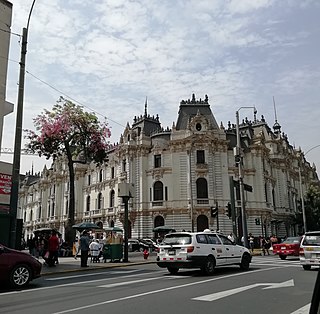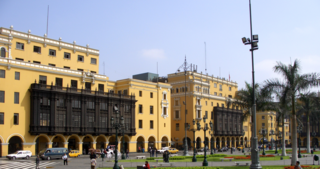
The Historic Centre of Lima is the historic city centre of the city of Lima, the capital of Peru. Located in the city's districts of Lima and Rímac, both in the Rímac Valley, it consists of two areas: the first is the Monumental Zone established by the Peruvian government in 1972, and the second one—contained within the first one—is the World Heritage Site established by UNESCO in 1988, whose buildings are marked with the organisation's black-and-white shield.

The Jirón de la Unión, or Union Street, is a pedestrian street located in the Historic Centre of Lima, part of the capital of Peru. For many decades it was the most important boulevards of the city, often described as the most aristocratic, where many of the most affluent citizens of the city and most powerful men around the world would meet. Subsequently, with the deterioration of the center of Lima, the Jirón de la Unión lost its aristocratic character and became completely commercialized.

The Dos de Mayo Square, known as the Óvalo de la Reina until 1866, is a public square located in Lima, Peru. Located on the southwestern edge of the historic centre's bufferzone, it serves as the junction of several important avenues, including Alfonso Ugarte, La Colmena and Colonial avenues. In the late 20th century, a vehicular tunnel was built under the square to curb traffic congestions.

The National Club is a private club and civil association based in the Plaza San Martín of the Historic Centre of Lima. Founded on October 19, 1855, it has been the meeting place for the Peruvian aristocracy throughout the 19th and 20th centuries, as its members are members of the most distinguished and wealthy families in the country.

The Rímac Building, also known as the Roosevelt House, is a building located in the centre of the city of Lima, Peru. It is currently under the administration of the insurance company Rímac Seguros. It is located at 101/157 Roosevelt Avenue and 1177/1199 Jirón de la Unión. It is the starting point of Paseo de la República Avenue.

Jirón Áncash is a major street in the Damero de Pizarro, located in the historic centre of Lima, Peru. The street starts at its intersection with the Jirón de la Unión at the Puente de Piedra, and continues until it reaches the Óvalo de la Paz.

Jirón Callao is a major street in the Damero de Pizarro, located in the historic centre of Lima, Peru. The street starts at its intersection with the Jirón Sancho de Rivera and continues until it reaches the Jirón de la Unión, next to the Plaza de Armas.

Jirón Apurímac is a street in the Damero de Pizarro, located in the historic centre of Lima, Peru. The street starts at its intersection with Abancay Avenue, behind the Javier Alzamora Valdez Building, and continues until it reaches Jirón Carabaya.

Jirón Huallaga is a major street in the Damero de Pizarro, located in the historic centre of Lima, Peru. The street starts at its intersection with the Jirón de la Unión at the Plaza Mayor and continues until it reaches Jirón Cangallo in Barrios Altos, about a block after it passes through the Plaza Italia.

Jirón Huancavelica is a major street in the Damero de Pizarro, located in the historic centre of Lima, Peru. The street starts at its intersection with the Jirón de la Unión and continues until it reaches Jirón Ramón Cárcano.

Jirón Ica is a major street in the Damero de Pizarro, located in the historic centre of Lima, Peru. The street starts at its intersection with the Jirón de la Unión and continues until it reaches the Jirón Sancho Rivera.

Jirón Junín is a major street in the Damero de Pizarro, located in the historic centre of Lima, Peru. The street starts at its intersection with the Jirón de la Unión and continues for 19 blocks until it reaches Nicolás Ayllón Avenue.

Emancipation Avenue, formerly known as Jirón Arequipa and Jirón Riva-Agüero, is a major avenue in the Damero de Pizarro, located in the historic centre of Lima, Peru. The street starts at its intersection with the Jirón de la Unión and continues until it reaches the Plaza Ramón Castilla. It is continued to the east by Jirón Cuzco, formerly part of the avenue.

Franklin D. Roosevelt Avenue, also known simply as Roosevelt Avenue, is an avenue of the historic centre of Lima, Peru. It starts at the Paseo de la República, continuing the path of Bolivia Avenue, and continues until it reaches Jirón Cotabambas, one block away from the public park of the National University of San Marcos.

Jirón Azángaro is a major street in the Damero de Pizarro, located in the historic centre of Lima, Peru. The street starts at its intersection with the Jirón Áncash and continues until it reaches Jirón Manuel Aljovín, next to the Palace of Justice.

Jirón Camaná is a major street in the Damero de Pizarro, located in the historic centre of Lima, Peru. The street starts at the Alameda Chabuca Granda and continues southwest until it reaches Jirón Jacinto López, next to the Plaza Francia, continuing directly south until it reaches Bolivia Avenue, next to the Lima Civic Center.

Uruguay Avenue is an avenue of the historic centre of Lima, Peru. It begins at its intersection with the Jirón de la Unión and continues until it reaches Alfonso Ugarte Avenue, where its path is continued by Venezuela Avenue, which crosses the entirety of the city until it reaches Callao.

Jirón Caylloma, also known as Jirón Cailloma, is a major street in the Damero de Pizarro, located in the historic centre of Lima, Peru. The street starts at its intersection with Jirón Conde de Superunda and continues until it reaches Jirón Quilca.

Jirón Rufino Torrico, formerly known as Jirón Arica, is a major street in the Damero de Pizarro, located in the historic centre of Lima, Peru. The street starts before its intersection with the Jirón Conde de Superunda, parallel to the Prolongación Tacna, and continues until it reaches Inca Garcilaso de la Vega Avenue.

The 1909 Peruvian coup d'état attempt was an attempted coup d'état carried out on May 29, 1909 by relatives of former president Nicolás de Piérola and supporters of the Democratic Party, known as "Pierolistas" for their support of the former president. The brief episode was motivated by political tensions between the party and Congress and dissatisfaction with the unemployment caused by the Panic of 1907.




















